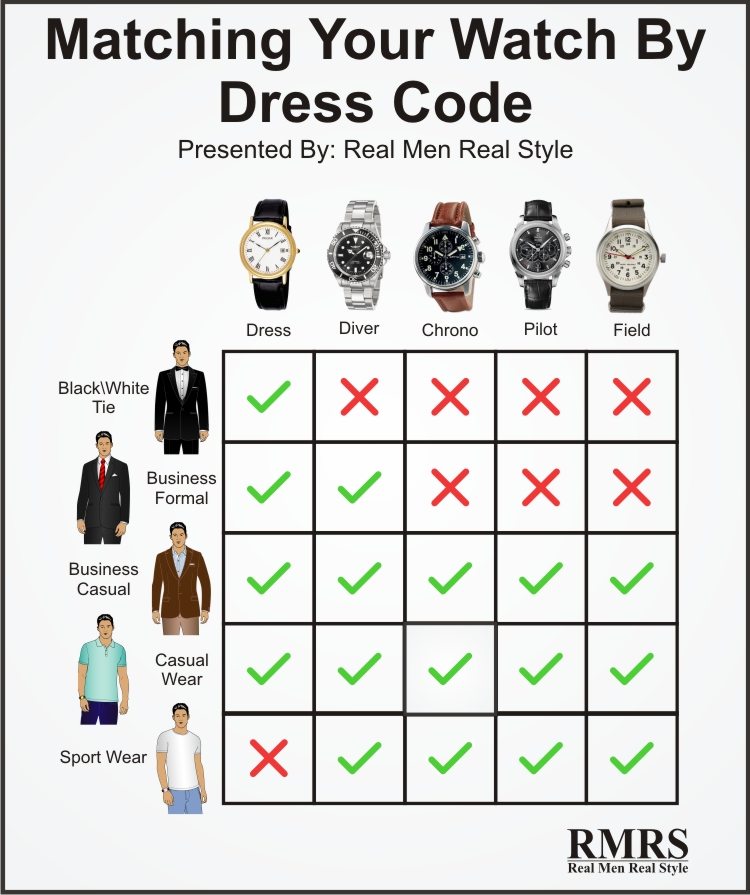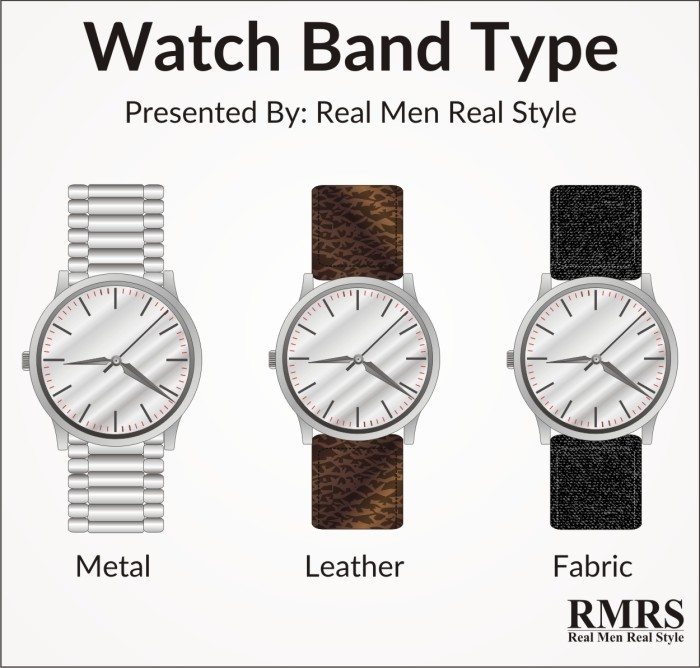Man’s Guide To Dress and Casual Watches
Selecting The Right Watch – The Details that Matter
Your options for a wristwatch are basically infinite. The only limiting factors are budget and taste.
That makes it an overwhelming process for a man who knows nothing about watches. Some choices will have to do with style and others with function, but here, in a nutshell, are the biggest decisions you will need to make when selecting a wristwatch:
Choice #1: One Watch or Multiple Watches?
If you plan on buying one watch and wearing it in all circumstances, it needs to be very stylistically neutral – able to pair with any color and any level of formality of dress.
If you're willing to own two or three watches, your options open up. One can be sleek and understated for maximum formality; another broad and shiny for a conversation piece.

If you only want to buy one watch, it needs to be reasonably restrained, and should almost certainly be a plain metal band and face rather than leather.
A black leather watch does not pair with brown leather shoes and vice versa (although many leather watches are designed to take interchangeable bands, at which point you could own one watch but multiple bands and still be covered for all situations).
Choice #2: Metal Band or Leather Strap?
Metal watch bands have the advantage of neutrality.
Your metals should always match, but men usually wear little jewelry – if you have a silver-tone watch band, it's easy enough to make sure you're also wearing a silver-tone belt buckle rather than a gold one.
Apart from belt buckles and cuff links, both of which are easily interchangeable, men don't usually have many metals to worry about. That makes a metal watch band a simple option.

Leather, on the other hand, needs to match your other leathers (typically shoes and belt), but can look simpler and less ostentatious than metal.
At the highest levels of formality, a plain black leather band is preferable to even a very sleek metal one. And in less formal situations, leather offers a more comfortable attitude, seeming a bit more approachable than solid metal.
There is no right answer. What does exist is a difference in attitude: metal is smooth, practical, and stern while leather is suave, sophisticated, and more personal.
Choose the one that suits your wardrobe and your personality best – or invest in multiple watches, or one watch with multiple bands.
Choice #3: Dial and Case Style
The dial of the watch is the round, visible face on which the hands move. The case is the metal that encloses both the dial and the movement (mechanism) behind it.
Most cases are metal, or plastic made to look like metal, and you will almost certainly want the former. Outside of sports watches or utility pieces for working professionals, there's little reason for a grown man to own a rubber or plastic watch.
Metals for cases can range from stainless steel to white gold and platinum and anything in between, including rarer options like titanium. They usually fall into either a silver-tone or gold-tone color family, or else are colored black or white.
Dials, on the other hand, range widely in color. Some are deliberately plain and simple (a black dial with a metal case is probably the most common option for men), while others have a bright color like the signature red of Victorinox (the company that makes Swiss Army knives).
The numbers usually contrast with the dial for readability, though the contrast can range from white-on-black to light blue on dark blue.
Overall, the more contrast the watch includes, the more noticeable and the less formal it is. A plain silver or steel case with a dark dial and small numbers is typical for business dress use, while casual watches can have a bit more color and contrast.
The shape of the case and dial are largely aesthetic choices. There's a small preference for rectangular dials and cases in modern business styles, but a round watch is certainly no faux pas. More unusual styles (triangular, etc.) would fall under the heading of casual-only wear, however.
Choice #4: The Movement Of The Watch Hands
The movement is where most men tend to get lost. Without going into too much detail, the movement is what keeps the actual time. There are basically three types of movement, although sub-categories exist among each:
- Mechanical movements are wound internally and keep time via the unwinding and winding of springs inside the watch. They need periodic winding (often done via an external cap or knob) and can lose accuracy over time.
- Automatic movements are also mechanical in nature, but use the motion of the watch itself to power their movements. They do not require winding, and are much more accurate so long as they are regularly worn or shaken to provide power.
- Electronic movements are often called quartz movements because of their most common construction, though not all electronic watches use real quartz. They keep the most accurate time so long as they are powered, but need a battery or other source of electricity such as a solar cell on the dial.
Electronic movements are much cheaper to produce, and most mechanical or automatic watches these days are a status symbol as much as a time piece. All three types of movements, properly cared for, will keep accurate enough time for most men's purposes, and a high-quality mechanical or automatic movement may be more accurate than a cheap quartz or electronic movement.
So Which Watch to Buy?
Much of the answer to that question ultimately comes down to taste. But a man buying a first-time watch who wants to use it in as many outfits as possible would do well to keep the following points in mind:
- Few watches will work with every outfit. You may need two to really round out your wardrobe.
- Metal bands are easier to match than leather, but leather can appear dressier and more natural.
- The colors of all your metals should match (wedding bands get an exception to the rule), and the colors of all your leathers should match. That means your watchband needs to go with the other metals and/or leathers in the outfit.
- The brighter, higher-contrast, and “busier” the dial, case, and numbers are, the less dressy the watch is.
- Watch movements vary in precision based on the quality of manufacture, but any of the three basic types can produce a reliable timepiece if properly cared for.
Understand your options and take the time to shop around a bit until you find a style you like.
Source https://www.realmenrealstyle.com/


































































